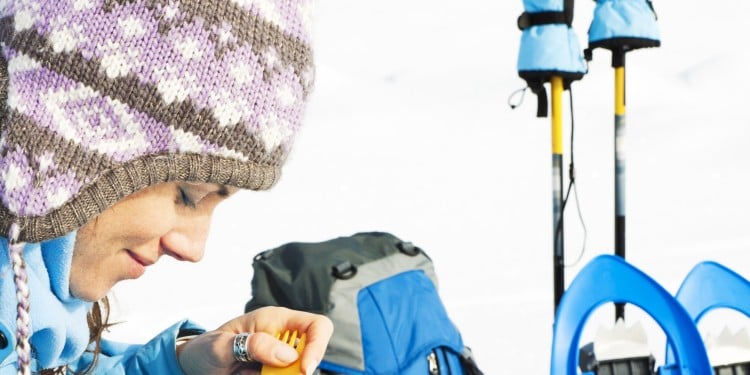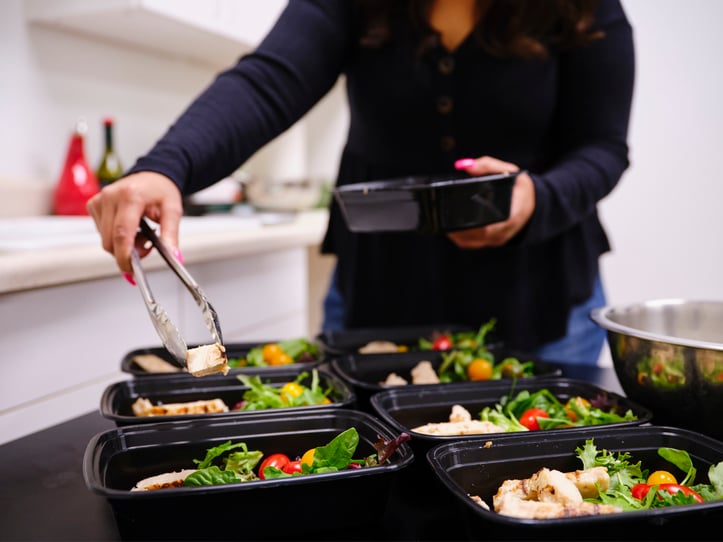If you have an overall balanced nutrient intake, your pre, during, and post workout fuel and hydration can make a huge impact on your performance, recovery between workouts, and injury prevention. Your overall training diet is more important than any pre, during, and post workout meal or snack!
If you haven’t been practicing your fueling like you have been training your body, it doesn’t matter what nutrition course you choose for your workout or training session. This overall nutrition approach is also important with colder temperature activities when we may forget to consider the increased importance of hydration. The focus of this article will cover cold temperatures and high altitude along with your pre, during, and post training nutrition needs.
Cold temperature acclimation is not as well understood as that of hot and humid climates. Hypothermia is one of the major concerns of cold temperature exposure. Hypothermia is when your body temperature drops below 98.6 degrees (or lower than your normal body temperature). With a lower body temperature, circulation to your extremities decreases and stays more centrally located in the abdomen to keep the vital organs warm. Mild hypothermia can decrease performance due to the lower blood flow to the working muscles.
Cold temperatures can offer their own sports nutrition challenges (as we discuss in our Nutrition Curriculum). Nutrition to prepare for cold temperatures includes consistently consuming adequate carbohydrates throughout your training. Include carbohydrates at meals, snacks, and before, during and after exercise as well. Eating both before workouts and after is essential for feeling your best during the workout as well as achieving goals of improved performance.
Between thirty and sixty minutes before training is the time to eat a snack. This snack should be carbohydrate-rich to top off muscle glycogen stores and may include a small amount of protein (depending on individual stomach tolerance). Protein helps build and repair muscle tissue, and adequate protein before exercise may help reduce post-exercise soreness.
General sports nutrition fuel timing guidelines for pre workout or training:
- 3 hours – 300 calories (High carbohydrate, moderate protein and small amount of fat. For example, whole grain cereal with fruit and Greek yogurt.)
- 2 hours – 200 calories (Carbohydrate and protein. For example, an egg and whole grain toast.) Plus two cups of fluid.
- 1 hour – 100 calories (Carbohydrate like fruit.)
- 15-20 minutes half to one cup of fluid.
During a workout your fuel intake will vary depending on how you’re training. Under one hour, fluid intake for hydration will be your main focus. Consuming 2-4 ounces of fluid every 15 minutes is recommended. Thirst is not a good indicator of hydration needs.
Training beyond one hour your fuel source should consist of 30 to 60 grams of carbohydrate per hour, evenly dispersed in 15-minute intervals with 2-4oz of fluid. The type of carbohydrate may be in the form of sports drinks, gels, blocks, and beans; or whole foods or homemade sources such as date bars. For fluids, if cold temperatures are particularly a concern with your performance, try warm fluids.
For recovery, a snack should be eaten within 15 to 30 minutes after finishing training. Again, this snack should include carbohydrate and protein. The purpose of the carbohydrate at this time is to replace the muscle fuel (glycogen) utilized during the workout. The protein will help stimulate the development of new muscle tissue. Carbohydrate and protein should be paired together as snacks both before training (less protein the closer to the start of the workout) and after, with the before snack being carbohydrate rich and the recovery snack being protein rich.
For every pound lost in sweat during training, 3 cups of fluid should be consumed to maximize recovery and decrease soreness. Dressing appropriately for cold weather training will be essential for assisting in maintaining hydration. Be sure to select moisture wicking fabrics to remove sweat and keep your skin dry, as well as removing extra layers of clothing as your body heat builds up.
Examples of Meal and Snack Timing with Training:
6:00 a.m. breakfast, 6:45 a.m. workout, 8:15 a.m. snack, 11:30 a.m.-12:30 p.m. lunch, 2:30-3 p.m. snack, 5:30 p.m. dinner, and possibly snack (only if physically hungry) 8-9 p.m.
6:30 a.m. breakfast, 9:30 a.m. snack, 11:30-12:30 p.m. workout, 1:00 p.m. lunch, 4-5 p.m. snack, dinner 6-7 p.m., and possibly snack (only if physically hungry) 8-9 p.m.
6:30 a.m. breakfast, 9:30 a.m. snack, 11:30-12:30 p.m. lunch, 3-4 p.m. snack, 5 p.m. workout, dinner 6-7 p.m., and possibly snack (only if physically hungry) 8-9 p.m.
Here are some great meal options for recovery:
- Grilled salmon served over brown rice; steamed cauliflower and broccoli; boiled red potatoes tossed with parsley and olive oil
- Garlic mushroom spinach pasta; green tossed salad (with garbanzo beans, red onion, cucumber and Italian dressing)
- Roasted chicken; baked sweet potato; roasted broccoli
Altitude is another winter sport nutrition concern. Altitude (defined by the United States Olympic Committee as greater than 5,000 feet) causes the oxygen molecules in your body to be more spaced out. Therefore, oxygen delivery to working muscles is decreased. At first, altitude can decrease performance, however, adaptation to train at higher altitudes is possible.
There are several points that can be made regarding altitude, but for the purpose here the focus will remain on nutrition. Training at altitude results in increased iron needs, increased fluid intake, consistent carbohydrate intake, increased resting metabolic rate and decreased appetite which can interfere with consistent fueling and may cause weight loss (especially due to increased calorie needs). All of these mentioned challenges can drastically effect performance.
Prepare your nutrition and hydration for altitude by regularly consuming fluids. Thirst is not a good indicator for hydration needs. Paying attention to your urine color is one of the best ways to determine hydration status. Look for regular urination with clear to pale yellow (straw) color.
If iron deficiency or anemia is already a concern be extra aware. Consuming a diet rich in iron to help carry oxygen to your working muscle is a great performance enhancer regardless of altitude. For altitude training, be sure to include iron rich foods in your diet like beef, eggs, tuna, lentils, beans, and iron fortified foods, and consume them with citrus foods to increase absorption.
Consume consistent meals and snacks (3 meals and 3 snacks) daily to maintain calorie needs and prevent weight loss. Be sure to include a carbohydrate (whole grains, fruits, and vegetables) as well as lean protein, and heart healthy fat at each meal. Even during snacks include a carbohydrate with a protein or a fat.
Research shows it can take up to two or three weeks to fully adapt to altitude for performance.
The winter months definitely bring their own set of performance needs. Paying attention to your body and its needs for performance by consistently fueling and hydrating will allow you to perform better, prevent injury, and recover faster. Here’s to staying active in the colder temperatures.
Sources:
Sports Nutrition; A Practice Manual for Professionals 5th Edition, Christine A. Rosenbloom, PhD, RD, CSSD, Editor in Chief.
United States Olympic Committee www.teamusa.org
















